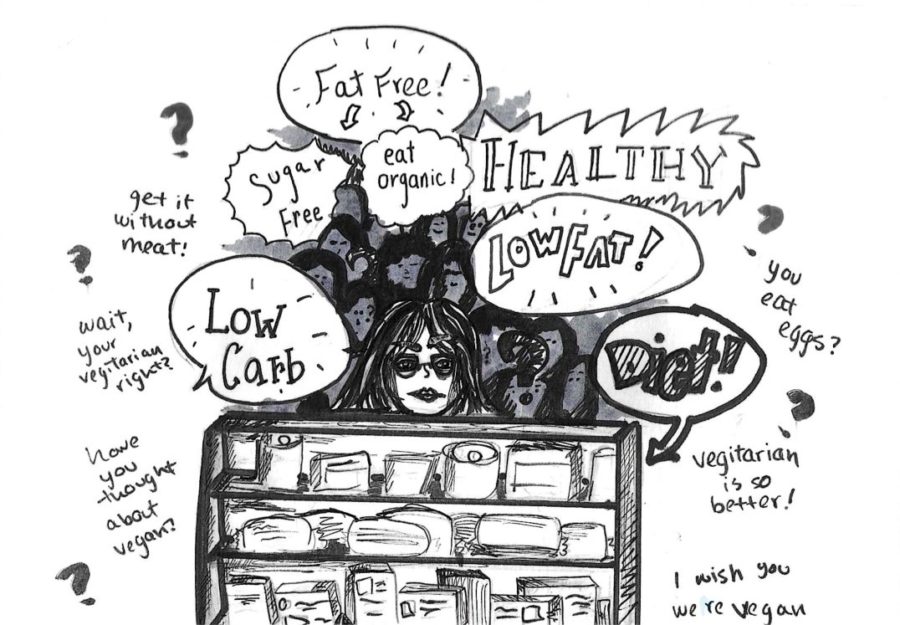Opinion | Wellness classes, the media, and unhealthy eating habits
January 27, 2023
Picture this: it’s sophomore year, and I’m sitting in my Wellness class on the second floor H-hall. Parents and students have already received an email giving us a heads-up on our next unit: nutrition education. It seems easy enough to infer what we’re going to cover over the next few weeks—the dangers of certain foods and how having too much or too little of them may affect your health. Soon enough, we’re dipping our feet into the pool of disordered eating and promptly becoming at-risk for the dangers that come with promoting unhealthy eating habits. Since Kindergarten, we’ve all sat through lessons on nutrition and eating, and this shouldn’t have been anything unfamiliar or unnerving. Except, for me, that was not the case.
I remember receiving a sheet of paper on which we had to write down the names of certain foods on the far left side, and the rest of the sheet is filled with nutritional information. But to me, a lot of the information we are being told to fill out just doesn’t seem to have any sort of beneficial factors. It was a pointless assignment that discouraged a healthy relationship with food, as did many other aspects of that class. Why should I care about the serving size for an avocado? Why should I be reminded that one single apple is the ‘typical’ serving size and after reaching that one apple limit, I should feel guilty about my eating habits?
As a teenager growing up in the 21st century, with all sorts of media outlets constantly shoved down my throat, it’s more than difficult. I’m watching body types and body weights go in and out of ‘style.’ Every day, I see a new way to lose weight quickly. I see people quite literally killing themselves to be the most “perfect” version of themselves. I’m not shaming anyone for this, and I will never blame us teenagers—the most gullible people—for doing so.
Principal Taya Kinzie elaborates on how the media proliferates body standards and disordered eating.
“[Normalizing calories] is a challenge because of [the] media’s assumption, right?”, Kinzie says.“The connotation is negative and shameful.”
Kinzie’s remark is completely accurate. It has become perpetually harder to steer away from the dangers that come with social media. According to the American Academy of Child & Adolescent Psychiatry, nearly 90 percent of teens (ages 13-17) have used social media. It’s inevitable that such a large percentage of our youth are affected by the media and its wide array of opinions pertaining to the ideal body type.
This is exactly why I believe it’s just as important to educate students on how to steer away from the ideas that the media instills in us, as it is to tell us about healthy eating. We need to emphasize the importance of stepping away from our screens and taking the time to ground ourselves. When we see something triggering, we shouldn’t simply continue on and pretend as if nothing happened. We must acknowledge those feelings and discuss how to dismiss the negative messages that are being forced onto us.
It’s possible that to some, a lesson about eating in Wellness class is not enough to substantially impact a student’s body image and eating habits. But to those that it does affect, more care must be included in the curriculum that humanizes food and our bodies. ETHS needs to re-consider the true importance of filling out a sheet that discusses something like the number of carbs and fat in a piece of whole wheat bread.
ETHS regularly reminds us of the fact that its administration is striving towards making this school welcoming for all. There’s an endless amount of improvements to be made within this school, and I think adjusting a lesson like this is only one small improvement within reach. Considering the struggles of others, while also ensuring that they’re being educated on nutrition is honestly the bare minimum for a school like ETHS. Hopefully, as the years pass, we grow from the feedback and comments received from students that have been through these hurtful lessons. This is a perfect opportunity to begin creating safer spaces for all.








